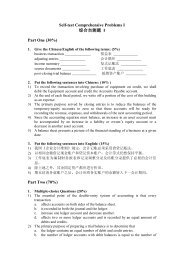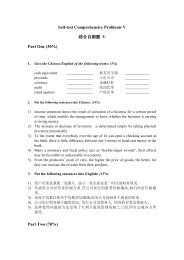Vodafone Group Plc Annual Report for the year ended 31 March 2012
Vodafone Group Plc Annual Report for the year ended 31 March 2012
Vodafone Group Plc Annual Report for the year ended 31 March 2012
You also want an ePaper? Increase the reach of your titles
YUMPU automatically turns print PDFs into web optimized ePapers that Google loves.
<strong>Vodafone</strong> <strong>Group</strong> <strong>Plc</strong><br />
<strong>Annual</strong> <strong>Report</strong> <strong>2012</strong> 126<br />
Notes to <strong>the</strong> consolidated financial statements (continued)<br />
21. Capital and financial risk management (continued)<br />
The following table presents ageing of receivables that are past due and provisions <strong>for</strong> doubtful receivables that have been established.<br />
Gross<br />
receivables<br />
Less<br />
provisions<br />
Net<br />
receivables<br />
<strong>2012</strong> 2011<br />
Gross<br />
receivables<br />
Less<br />
provisions<br />
Net<br />
receivables<br />
£m £m £m £m £m £m<br />
30 days or less 1,914 (390) 1,524 1,933 (372) 1,561<br />
Between <strong>31</strong> – 60 days 192 (21) 171 140 (40) 100<br />
Between 61 – 180 days 435 (96) 339 157 (72) 85<br />
Greater than 180 days 598 (433) 165 778 (480) 298<br />
3,139 (940) 2,199 3,008 (964) 2,044<br />
Concentrations of credit risk with respect to trade receivables are limited given that <strong>the</strong> <strong>Group</strong>’s customer base is large and unrelated. Due to this<br />
management believes <strong>the</strong>re is no fur<strong>the</strong>r credit risk provision required in excess of <strong>the</strong> normal provision <strong>for</strong> bad and doubtful receivables. Amounts<br />
charged to administrative expenses during <strong>the</strong> <strong>year</strong> <strong>ended</strong> <strong>31</strong> <strong>March</strong> <strong>2012</strong> were £458 million (2011: £460 million, 2010: £465 million) (see note 17).<br />
The <strong>Group</strong>’s investments in preferred equity and a subordinated loan received as part of <strong>the</strong> disposal of <strong>Vodafone</strong> Japan to SoftBank in <strong>the</strong> 2007<br />
financial <strong>year</strong> were disposed of in <strong>the</strong> prior <strong>year</strong>. The <strong>Group</strong> has a receivable of £1,514 million (2011: £1,488 million) in relation to <strong>the</strong> second tranche<br />
of consideration receivable in relation to <strong>the</strong> disposal. This amount was received on 2 April <strong>2012</strong>.<br />
As discussed in note 29 <strong>the</strong> <strong>Group</strong> has covenanted to provide security in favour of <strong>the</strong> Trustee of <strong>the</strong> <strong>Vodafone</strong> <strong>Group</strong> UK Pension Scheme in respect<br />
of <strong>the</strong> funding deficit in <strong>the</strong> scheme. The security takes <strong>the</strong> <strong>for</strong>m of an English law pledge over UK index linked government bonds.<br />
Liquidity risk<br />
At <strong>31</strong> <strong>March</strong> <strong>2012</strong> <strong>the</strong> <strong>Group</strong> had €4.2 billion and US$4.2 billion syndicated committed undrawn bank facilities and US$15 billion and £5 billion<br />
commercial paper programmes, supported by <strong>the</strong> €4.2 billion and US$4.2 billion syndicated committed bank facilities, available to manage its<br />
liquidity. The <strong>Group</strong> uses commercial paper and bank facilities to manage short-term liquidity and manages long-term liquidity by raising funds in<br />
<strong>the</strong> capital markets.<br />
€4.2 billion of <strong>the</strong> syndicated committed facility has a maturity date of 1 July 2015. US$4.2 billion has a maturity of 9 <strong>March</strong> 2016; during <strong>the</strong> <strong>year</strong><br />
US$4.1 billion of this facility was ext<strong>ended</strong> by one <strong>year</strong>, now maturing 9 <strong>March</strong> 2017. Both facilities have remained undrawn throughout <strong>the</strong> financial<br />
<strong>year</strong> and since <strong>year</strong> end and provide liquidity support.<br />
The <strong>Group</strong> manages liquidity risk on long-term borrowings by maintaining a varied maturity profile with a cap on <strong>the</strong> level of debt maturing in any<br />
one calendar <strong>year</strong>, <strong>the</strong>re<strong>for</strong>e minimising refinancing risk. Long-term borrowings mature between one and 25 <strong>year</strong>s.<br />
Liquidity is reviewed daily on at least a 12 month rolling basis and stress tested on <strong>the</strong> assumption that all commercial paper outstanding matures<br />
and is not reissued. The <strong>Group</strong> maintains substantial cash and cash equivalents which at <strong>31</strong> <strong>March</strong> <strong>2012</strong> amounted to £7,138 million<br />
(2011: £6,252 million).<br />
Market risk<br />
Interest rate management<br />
Under <strong>the</strong> <strong>Group</strong>’s interest rate management policy, interest rates on monetary assets and liabilities denominated in euros, US dollars and sterling<br />
are maintained on a floating rate basis except <strong>for</strong> periods up to six <strong>year</strong>s where interest rate fixing has to be undertaken in accordance with treasury<br />
policy. Where assets and liabilities are denominated in o<strong>the</strong>r currencies interest rates may also be fixed. In addition, fixing is undertaken <strong>for</strong> longer<br />
periods when interest rates are statistically low.<br />
For each one hundred basis point fall or rise in market interest rates <strong>for</strong> all currencies in which <strong>the</strong> <strong>Group</strong> had borrowings at <strong>31</strong> <strong>March</strong> <strong>2012</strong> <strong>the</strong>re<br />
would be a reduction or increase in profit be<strong>for</strong>e tax by approximately £33 million (2011: increase or reduce by £30 million) including mark-tomarket<br />
revaluations of interest rate and o<strong>the</strong>r derivatives and <strong>the</strong> potential interest on outstanding tax issues. There would be no material impact<br />
on equity.






